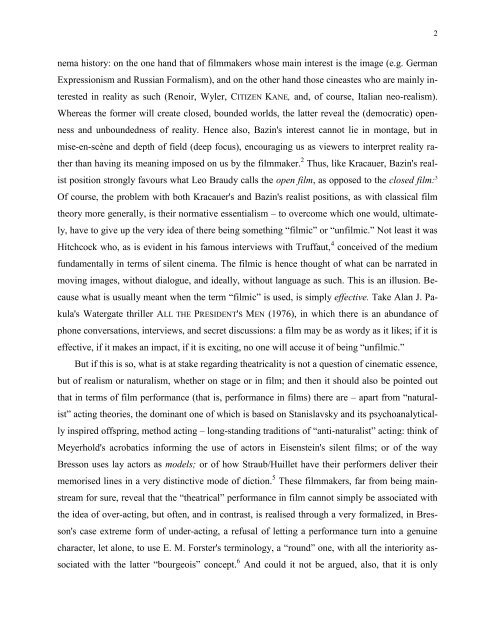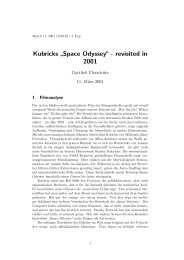Henry M. Taylor, 'Frames, Cons, and Double-Crosses - Cinetext
Henry M. Taylor, 'Frames, Cons, and Double-Crosses - Cinetext
Henry M. Taylor, 'Frames, Cons, and Double-Crosses - Cinetext
Create successful ePaper yourself
Turn your PDF publications into a flip-book with our unique Google optimized e-Paper software.
nema history: on the one h<strong>and</strong> that of filmmakers whose main interest is the image (e.g. German<br />
Expressionism <strong>and</strong> Russian Formalism), <strong>and</strong> on the other h<strong>and</strong> those cineastes who are mainly in-<br />
terested in reality as such (Renoir, Wyler, CITIZEN KANE, <strong>and</strong>, of course, Italian neo-realism).<br />
Whereas the former will create closed, bounded worlds, the latter reveal the (democratic) open-<br />
ness <strong>and</strong> unboundedness of reality. Hence also, Bazin's interest cannot lie in montage, but in<br />
mise-en-scène <strong>and</strong> depth of field (deep focus), encouraging us as viewers to interpret reality ra-<br />
ther than having its meaning imposed on us by the filmmaker. 2 Thus, like Kracauer, Bazin's real-<br />
ist position strongly favours what Leo Braudy calls the open film, as opposed to the closed film: 3<br />
Of course, the problem with both Kracauer's <strong>and</strong> Bazin's realist positions, as with classical film<br />
theory more generally, is their normative essentialism – to overcome which one would, ultimate-<br />
ly, have to give up the very idea of there being something ―filmic‖ or ―unfilmic.‖ Not least it was<br />
Hitchcock who, as is evident in his famous interviews with Truffaut, 4 conceived of the medium<br />
fundamentally in terms of silent cinema. The filmic is hence thought of what can be narrated in<br />
moving images, without dialogue, <strong>and</strong> ideally, without language as such. This is an illusion. Be-<br />
cause what is usually meant when the term ―filmic‖ is used, is simply effective. Take Alan J. Pa-<br />
kula's Watergate thriller ALL THE PRESIDENT'S MEN (1976), in which there is an abundance of<br />
phone conversations, interviews, <strong>and</strong> secret discussions: a film may be as wordy as it likes; if it is<br />
effective, if it makes an impact, if it is exciting, no one will accuse it of being ―unfilmic.‖<br />
But if this is so, what is at stake regarding theatricality is not a question of cinematic essence,<br />
but of realism or naturalism, whether on stage or in film; <strong>and</strong> then it should also be pointed out<br />
that in terms of film performance (that is, performance in films) there are – apart from ―natural-<br />
ist‖ acting theories, the dominant one of which is based on Stanislavsky <strong>and</strong> its psychoanalytical-<br />
ly inspired offspring, method acting – long-st<strong>and</strong>ing traditions of ―anti-naturalist‖ acting: think of<br />
Meyerhold's acrobatics informing the use of actors in Eisenstein's silent films; or of the way<br />
Bresson uses lay actors as models; or of how Straub/Huillet have their performers deliver their<br />
memorised lines in a very distinctive mode of diction. 5 These filmmakers, far from being main-<br />
stream for sure, reveal that the ―theatrical‖ performance in film cannot simply be associated with<br />
the idea of over-acting, but often, <strong>and</strong> in contrast, is realised through a very formalized, in Bres-<br />
son's case extreme form of under-acting, a refusal of letting a performance turn into a genuine<br />
character, let alone, to use E. M. Forster's terminology, a ―round‖ one, with all the interiority as-<br />
sociated with the latter ―bourgeois‖ concept. 6 And could it not be argued, also, that it is only<br />
2



